Evidence-Based Health and Safety Analysis (EHSA) in Megaprojects
VerifiedAdded on 2023/06/10
|31
|10506
|240
Report
AI Summary
This report introduces a new evidence-based health and safety analysis (EHSA) approach for megaprojects, addressing the technical challenges in health and safety management. It aims to establish a conceptual EHSA framework to support evidence-based learning in practice-oriented research for large-scale complex health and safety management. The EHSA approach seeks to facilitate data collection from professional knowledge about accidents, failures, good practices, and innovations to inform improved health and safety management methods. Through a scenario-based case study, the report demonstrates how the EHSA approach can effectively support health and safety management in megaprojects, contributing to the body of knowledge and informing future practice and research at strategic and tactical levels. The report also reviews current international practices and academic research covering design, construction, and operation stages to establish a comprehensive understanding of health and safety management throughout a megaproject's lifecycle.
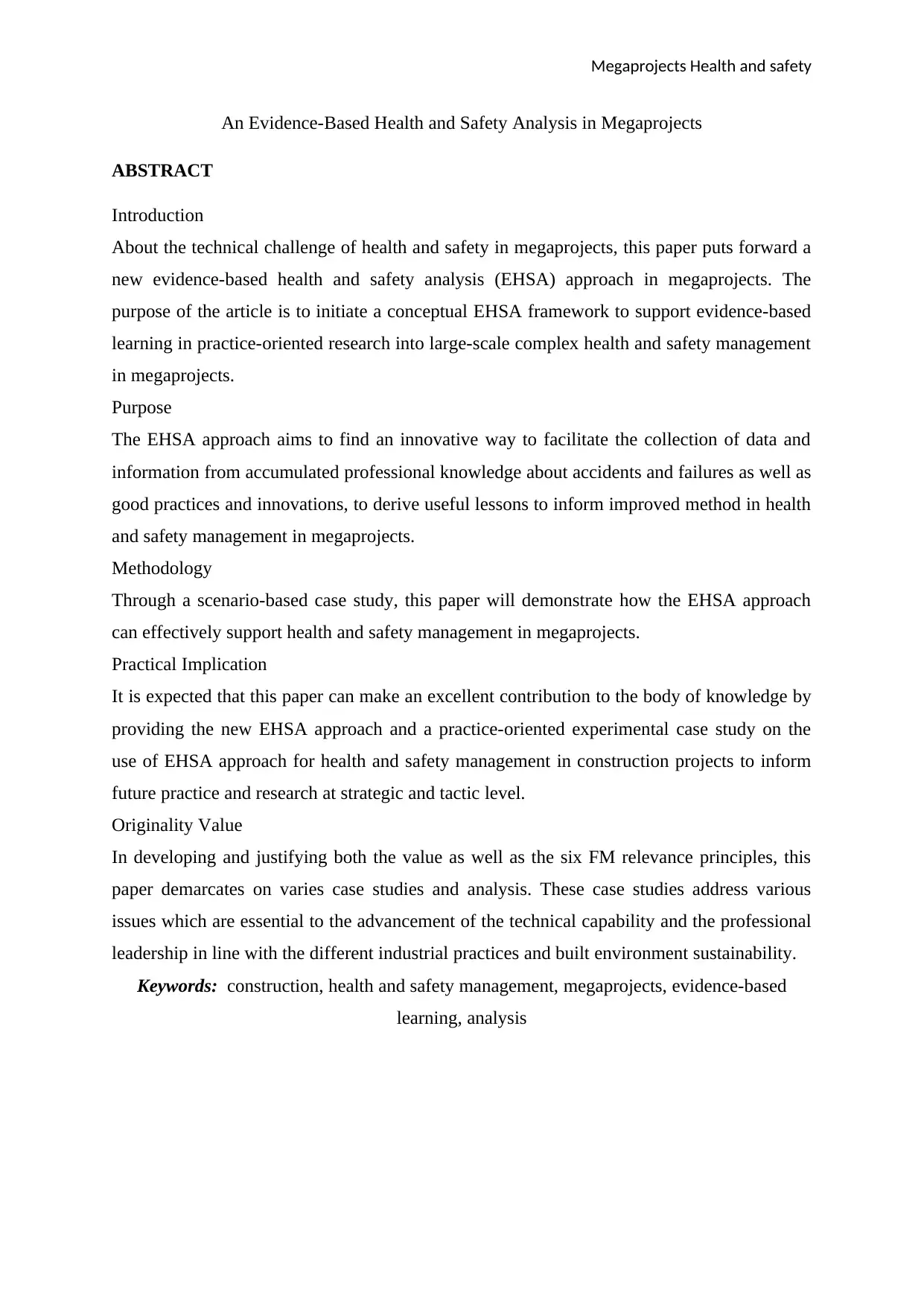
Megaprojects Health and safety
An Evidence-Based Health and Safety Analysis in Megaprojects
ABSTRACT
Introduction
About the technical challenge of health and safety in megaprojects, this paper puts forward a
new evidence-based health and safety analysis (EHSA) approach in megaprojects. The
purpose of the article is to initiate a conceptual EHSA framework to support evidence-based
learning in practice-oriented research into large-scale complex health and safety management
in megaprojects.
Purpose
The EHSA approach aims to find an innovative way to facilitate the collection of data and
information from accumulated professional knowledge about accidents and failures as well as
good practices and innovations, to derive useful lessons to inform improved method in health
and safety management in megaprojects.
Methodology
Through a scenario-based case study, this paper will demonstrate how the EHSA approach
can effectively support health and safety management in megaprojects.
Practical Implication
It is expected that this paper can make an excellent contribution to the body of knowledge by
providing the new EHSA approach and a practice-oriented experimental case study on the
use of EHSA approach for health and safety management in construction projects to inform
future practice and research at strategic and tactic level.
Originality Value
In developing and justifying both the value as well as the six FM relevance principles, this
paper demarcates on varies case studies and analysis. These case studies address various
issues which are essential to the advancement of the technical capability and the professional
leadership in line with the different industrial practices and built environment sustainability.
Keywords: construction, health and safety management, megaprojects, evidence-based
learning, analysis
An Evidence-Based Health and Safety Analysis in Megaprojects
ABSTRACT
Introduction
About the technical challenge of health and safety in megaprojects, this paper puts forward a
new evidence-based health and safety analysis (EHSA) approach in megaprojects. The
purpose of the article is to initiate a conceptual EHSA framework to support evidence-based
learning in practice-oriented research into large-scale complex health and safety management
in megaprojects.
Purpose
The EHSA approach aims to find an innovative way to facilitate the collection of data and
information from accumulated professional knowledge about accidents and failures as well as
good practices and innovations, to derive useful lessons to inform improved method in health
and safety management in megaprojects.
Methodology
Through a scenario-based case study, this paper will demonstrate how the EHSA approach
can effectively support health and safety management in megaprojects.
Practical Implication
It is expected that this paper can make an excellent contribution to the body of knowledge by
providing the new EHSA approach and a practice-oriented experimental case study on the
use of EHSA approach for health and safety management in construction projects to inform
future practice and research at strategic and tactic level.
Originality Value
In developing and justifying both the value as well as the six FM relevance principles, this
paper demarcates on varies case studies and analysis. These case studies address various
issues which are essential to the advancement of the technical capability and the professional
leadership in line with the different industrial practices and built environment sustainability.
Keywords: construction, health and safety management, megaprojects, evidence-based
learning, analysis
Paraphrase This Document
Need a fresh take? Get an instant paraphrase of this document with our AI Paraphraser
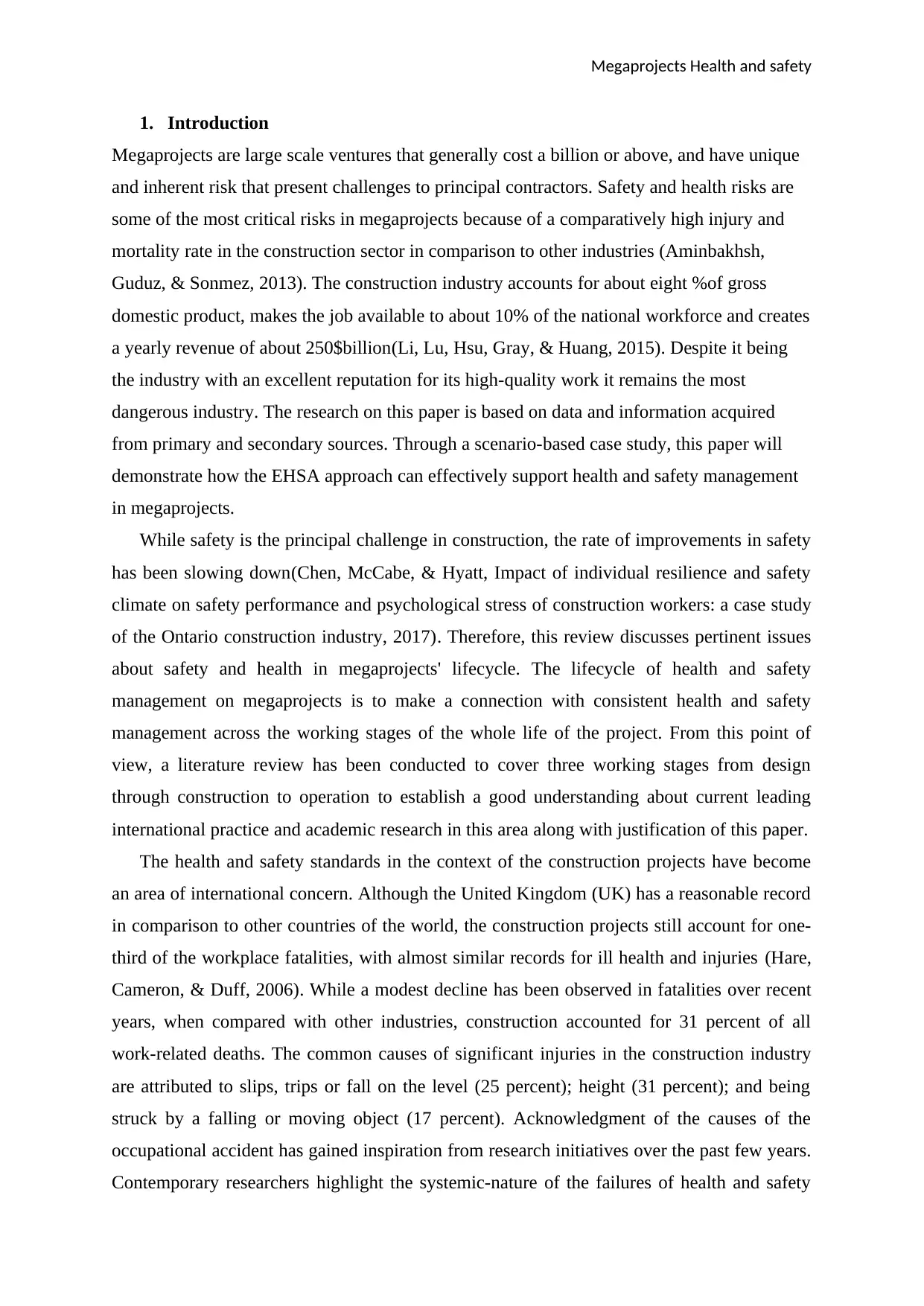
Megaprojects Health and safety
1. Introduction
Megaprojects are large scale ventures that generally cost a billion or above, and have unique
and inherent risk that present challenges to principal contractors. Safety and health risks are
some of the most critical risks in megaprojects because of a comparatively high injury and
mortality rate in the construction sector in comparison to other industries (Aminbakhsh,
Guduz, & Sonmez, 2013). The construction industry accounts for about eight %of gross
domestic product, makes the job available to about 10% of the national workforce and creates
a yearly revenue of about 250$billion(Li, Lu, Hsu, Gray, & Huang, 2015). Despite it being
the industry with an excellent reputation for its high-quality work it remains the most
dangerous industry. The research on this paper is based on data and information acquired
from primary and secondary sources. Through a scenario-based case study, this paper will
demonstrate how the EHSA approach can effectively support health and safety management
in megaprojects.
While safety is the principal challenge in construction, the rate of improvements in safety
has been slowing down(Chen, McCabe, & Hyatt, Impact of individual resilience and safety
climate on safety performance and psychological stress of construction workers: a case study
of the Ontario construction industry, 2017). Therefore, this review discusses pertinent issues
about safety and health in megaprojects' lifecycle. The lifecycle of health and safety
management on megaprojects is to make a connection with consistent health and safety
management across the working stages of the whole life of the project. From this point of
view, a literature review has been conducted to cover three working stages from design
through construction to operation to establish a good understanding about current leading
international practice and academic research in this area along with justification of this paper.
The health and safety standards in the context of the construction projects have become
an area of international concern. Although the United Kingdom (UK) has a reasonable record
in comparison to other countries of the world, the construction projects still account for one-
third of the workplace fatalities, with almost similar records for ill health and injuries (Hare,
Cameron, & Duff, 2006). While a modest decline has been observed in fatalities over recent
years, when compared with other industries, construction accounted for 31 percent of all
work-related deaths. The common causes of significant injuries in the construction industry
are attributed to slips, trips or fall on the level (25 percent); height (31 percent); and being
struck by a falling or moving object (17 percent). Acknowledgment of the causes of the
occupational accident has gained inspiration from research initiatives over the past few years.
Contemporary researchers highlight the systemic-nature of the failures of health and safety
1. Introduction
Megaprojects are large scale ventures that generally cost a billion or above, and have unique
and inherent risk that present challenges to principal contractors. Safety and health risks are
some of the most critical risks in megaprojects because of a comparatively high injury and
mortality rate in the construction sector in comparison to other industries (Aminbakhsh,
Guduz, & Sonmez, 2013). The construction industry accounts for about eight %of gross
domestic product, makes the job available to about 10% of the national workforce and creates
a yearly revenue of about 250$billion(Li, Lu, Hsu, Gray, & Huang, 2015). Despite it being
the industry with an excellent reputation for its high-quality work it remains the most
dangerous industry. The research on this paper is based on data and information acquired
from primary and secondary sources. Through a scenario-based case study, this paper will
demonstrate how the EHSA approach can effectively support health and safety management
in megaprojects.
While safety is the principal challenge in construction, the rate of improvements in safety
has been slowing down(Chen, McCabe, & Hyatt, Impact of individual resilience and safety
climate on safety performance and psychological stress of construction workers: a case study
of the Ontario construction industry, 2017). Therefore, this review discusses pertinent issues
about safety and health in megaprojects' lifecycle. The lifecycle of health and safety
management on megaprojects is to make a connection with consistent health and safety
management across the working stages of the whole life of the project. From this point of
view, a literature review has been conducted to cover three working stages from design
through construction to operation to establish a good understanding about current leading
international practice and academic research in this area along with justification of this paper.
The health and safety standards in the context of the construction projects have become
an area of international concern. Although the United Kingdom (UK) has a reasonable record
in comparison to other countries of the world, the construction projects still account for one-
third of the workplace fatalities, with almost similar records for ill health and injuries (Hare,
Cameron, & Duff, 2006). While a modest decline has been observed in fatalities over recent
years, when compared with other industries, construction accounted for 31 percent of all
work-related deaths. The common causes of significant injuries in the construction industry
are attributed to slips, trips or fall on the level (25 percent); height (31 percent); and being
struck by a falling or moving object (17 percent). Acknowledgment of the causes of the
occupational accident has gained inspiration from research initiatives over the past few years.
Contemporary researchers highlight the systemic-nature of the failures of health and safety
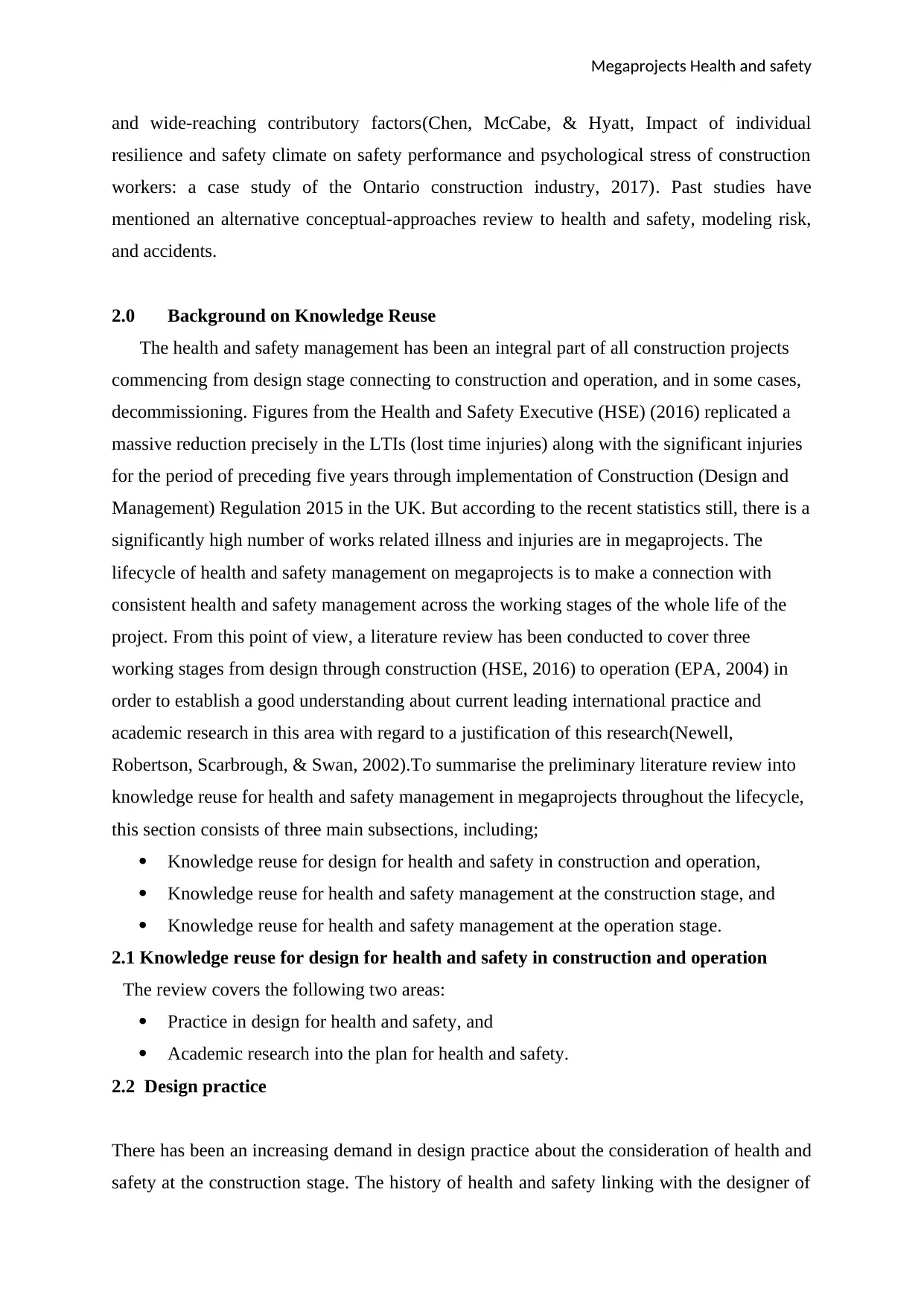
Megaprojects Health and safety
and wide-reaching contributory factors(Chen, McCabe, & Hyatt, Impact of individual
resilience and safety climate on safety performance and psychological stress of construction
workers: a case study of the Ontario construction industry, 2017). Past studies have
mentioned an alternative conceptual-approaches review to health and safety, modeling risk,
and accidents.
2.0 Background on Knowledge Reuse
The health and safety management has been an integral part of all construction projects
commencing from design stage connecting to construction and operation, and in some cases,
decommissioning. Figures from the Health and Safety Executive (HSE) (2016) replicated a
massive reduction precisely in the LTIs (lost time injuries) along with the significant injuries
for the period of preceding five years through implementation of Construction (Design and
Management) Regulation 2015 in the UK. But according to the recent statistics still, there is a
significantly high number of works related illness and injuries are in megaprojects. The
lifecycle of health and safety management on megaprojects is to make a connection with
consistent health and safety management across the working stages of the whole life of the
project. From this point of view, a literature review has been conducted to cover three
working stages from design through construction (HSE, 2016) to operation (EPA, 2004) in
order to establish a good understanding about current leading international practice and
academic research in this area with regard to a justification of this research(Newell,
Robertson, Scarbrough, & Swan, 2002).To summarise the preliminary literature review into
knowledge reuse for health and safety management in megaprojects throughout the lifecycle,
this section consists of three main subsections, including;
Knowledge reuse for design for health and safety in construction and operation,
Knowledge reuse for health and safety management at the construction stage, and
Knowledge reuse for health and safety management at the operation stage.
2.1 Knowledge reuse for design for health and safety in construction and operation
The review covers the following two areas:
Practice in design for health and safety, and
Academic research into the plan for health and safety.
2.2 Design practice
There has been an increasing demand in design practice about the consideration of health and
safety at the construction stage. The history of health and safety linking with the designer of
and wide-reaching contributory factors(Chen, McCabe, & Hyatt, Impact of individual
resilience and safety climate on safety performance and psychological stress of construction
workers: a case study of the Ontario construction industry, 2017). Past studies have
mentioned an alternative conceptual-approaches review to health and safety, modeling risk,
and accidents.
2.0 Background on Knowledge Reuse
The health and safety management has been an integral part of all construction projects
commencing from design stage connecting to construction and operation, and in some cases,
decommissioning. Figures from the Health and Safety Executive (HSE) (2016) replicated a
massive reduction precisely in the LTIs (lost time injuries) along with the significant injuries
for the period of preceding five years through implementation of Construction (Design and
Management) Regulation 2015 in the UK. But according to the recent statistics still, there is a
significantly high number of works related illness and injuries are in megaprojects. The
lifecycle of health and safety management on megaprojects is to make a connection with
consistent health and safety management across the working stages of the whole life of the
project. From this point of view, a literature review has been conducted to cover three
working stages from design through construction (HSE, 2016) to operation (EPA, 2004) in
order to establish a good understanding about current leading international practice and
academic research in this area with regard to a justification of this research(Newell,
Robertson, Scarbrough, & Swan, 2002).To summarise the preliminary literature review into
knowledge reuse for health and safety management in megaprojects throughout the lifecycle,
this section consists of three main subsections, including;
Knowledge reuse for design for health and safety in construction and operation,
Knowledge reuse for health and safety management at the construction stage, and
Knowledge reuse for health and safety management at the operation stage.
2.1 Knowledge reuse for design for health and safety in construction and operation
The review covers the following two areas:
Practice in design for health and safety, and
Academic research into the plan for health and safety.
2.2 Design practice
There has been an increasing demand in design practice about the consideration of health and
safety at the construction stage. The history of health and safety linking with the designer of
⊘ This is a preview!⊘
Do you want full access?
Subscribe today to unlock all pages.

Trusted by 1+ million students worldwide
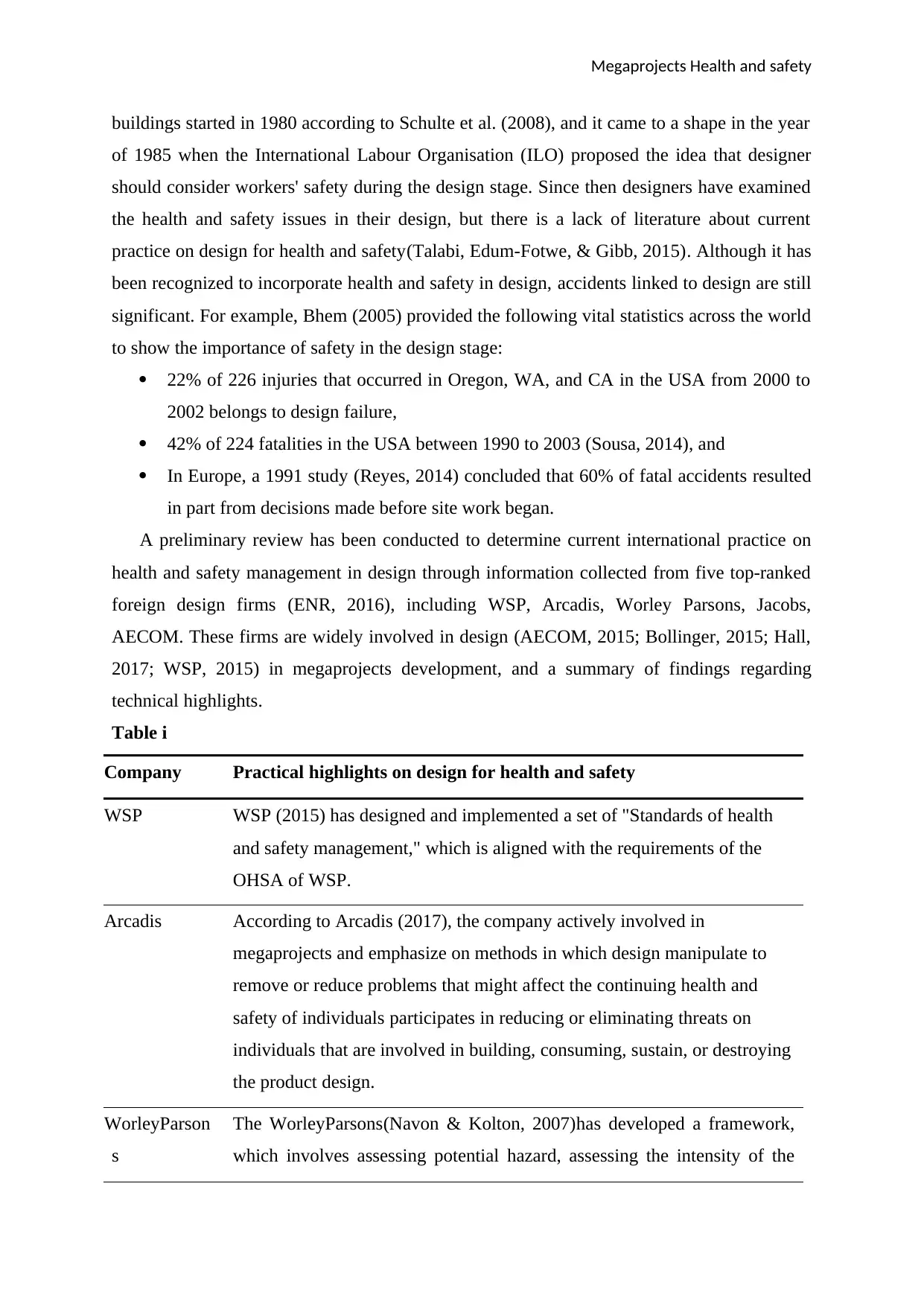
Megaprojects Health and safety
buildings started in 1980 according to Schulte et al. (2008), and it came to a shape in the year
of 1985 when the International Labour Organisation (ILO) proposed the idea that designer
should consider workers' safety during the design stage. Since then designers have examined
the health and safety issues in their design, but there is a lack of literature about current
practice on design for health and safety(Talabi, Edum-Fotwe, & Gibb, 2015). Although it has
been recognized to incorporate health and safety in design, accidents linked to design are still
significant. For example, Bhem (2005) provided the following vital statistics across the world
to show the importance of safety in the design stage:
22% of 226 injuries that occurred in Oregon, WA, and CA in the USA from 2000 to
2002 belongs to design failure,
42% of 224 fatalities in the USA between 1990 to 2003 (Sousa, 2014), and
In Europe, a 1991 study (Reyes, 2014) concluded that 60% of fatal accidents resulted
in part from decisions made before site work began.
A preliminary review has been conducted to determine current international practice on
health and safety management in design through information collected from five top-ranked
foreign design firms (ENR, 2016), including WSP, Arcadis, Worley Parsons, Jacobs,
AECOM. These firms are widely involved in design (AECOM, 2015; Bollinger, 2015; Hall,
2017; WSP, 2015) in megaprojects development, and a summary of findings regarding
technical highlights.
Table i
Company Practical highlights on design for health and safety
WSP WSP (2015) has designed and implemented a set of "Standards of health
and safety management," which is aligned with the requirements of the
OHSA of WSP.
Arcadis According to Arcadis (2017), the company actively involved in
megaprojects and emphasize on methods in which design manipulate to
remove or reduce problems that might affect the continuing health and
safety of individuals participates in reducing or eliminating threats on
individuals that are involved in building, consuming, sustain, or destroying
the product design.
WorleyParson
s
The WorleyParsons(Navon & Kolton, 2007)has developed a framework,
which involves assessing potential hazard, assessing the intensity of the
buildings started in 1980 according to Schulte et al. (2008), and it came to a shape in the year
of 1985 when the International Labour Organisation (ILO) proposed the idea that designer
should consider workers' safety during the design stage. Since then designers have examined
the health and safety issues in their design, but there is a lack of literature about current
practice on design for health and safety(Talabi, Edum-Fotwe, & Gibb, 2015). Although it has
been recognized to incorporate health and safety in design, accidents linked to design are still
significant. For example, Bhem (2005) provided the following vital statistics across the world
to show the importance of safety in the design stage:
22% of 226 injuries that occurred in Oregon, WA, and CA in the USA from 2000 to
2002 belongs to design failure,
42% of 224 fatalities in the USA between 1990 to 2003 (Sousa, 2014), and
In Europe, a 1991 study (Reyes, 2014) concluded that 60% of fatal accidents resulted
in part from decisions made before site work began.
A preliminary review has been conducted to determine current international practice on
health and safety management in design through information collected from five top-ranked
foreign design firms (ENR, 2016), including WSP, Arcadis, Worley Parsons, Jacobs,
AECOM. These firms are widely involved in design (AECOM, 2015; Bollinger, 2015; Hall,
2017; WSP, 2015) in megaprojects development, and a summary of findings regarding
technical highlights.
Table i
Company Practical highlights on design for health and safety
WSP WSP (2015) has designed and implemented a set of "Standards of health
and safety management," which is aligned with the requirements of the
OHSA of WSP.
Arcadis According to Arcadis (2017), the company actively involved in
megaprojects and emphasize on methods in which design manipulate to
remove or reduce problems that might affect the continuing health and
safety of individuals participates in reducing or eliminating threats on
individuals that are involved in building, consuming, sustain, or destroying
the product design.
WorleyParson
s
The WorleyParsons(Navon & Kolton, 2007)has developed a framework,
which involves assessing potential hazard, assessing the intensity of the
Paraphrase This Document
Need a fresh take? Get an instant paraphrase of this document with our AI Paraphraser
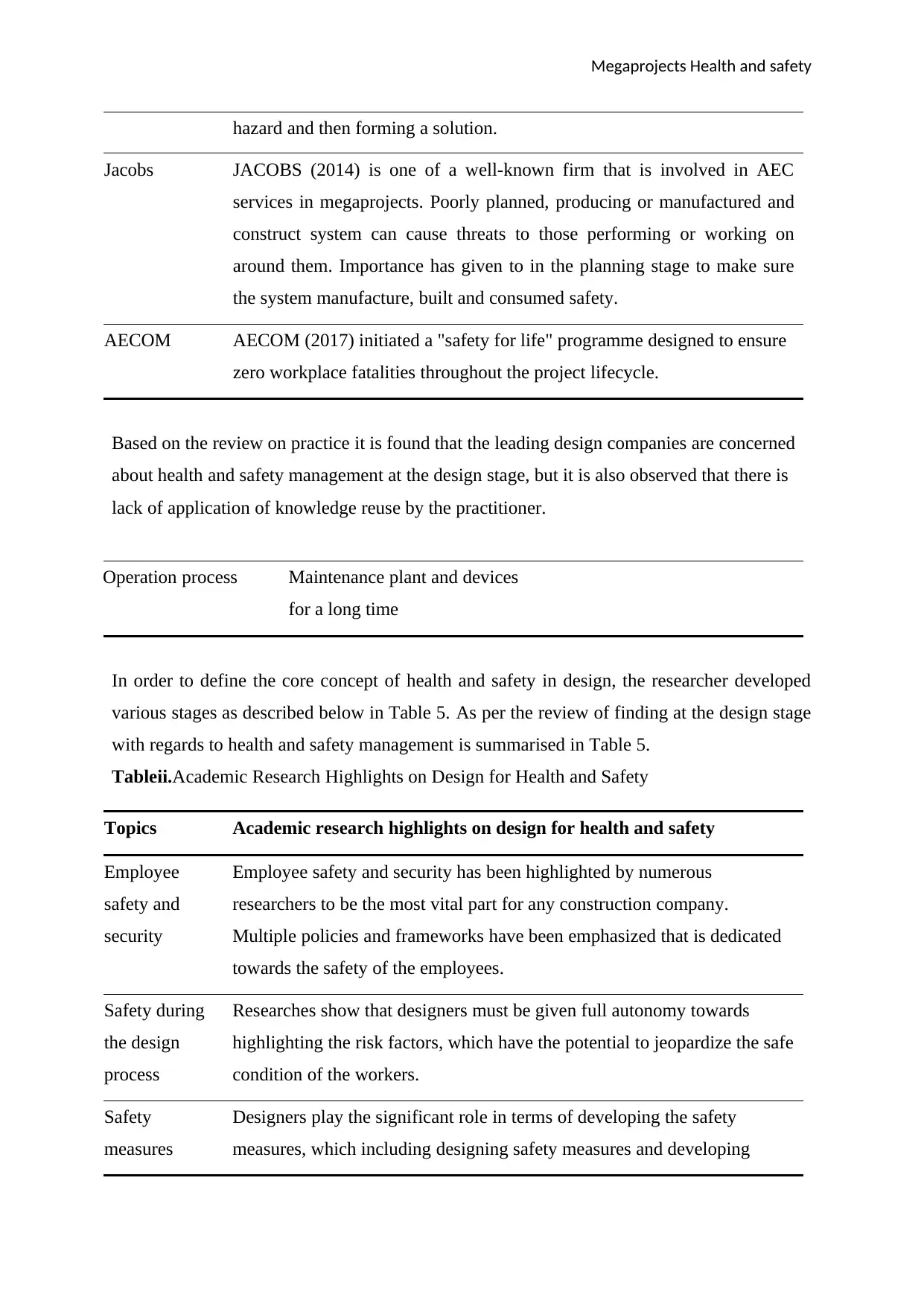
Megaprojects Health and safety
hazard and then forming a solution.
Jacobs JACOBS (2014) is one of a well-known firm that is involved in AEC
services in megaprojects. Poorly planned, producing or manufactured and
construct system can cause threats to those performing or working on
around them. Importance has given to in the planning stage to make sure
the system manufacture, built and consumed safety.
AECOM AECOM (2017) initiated a "safety for life" programme designed to ensure
zero workplace fatalities throughout the project lifecycle.
Based on the review on practice it is found that the leading design companies are concerned
about health and safety management at the design stage, but it is also observed that there is
lack of application of knowledge reuse by the practitioner.
Operation process Maintenance plant and devices
for a long time
In order to define the core concept of health and safety in design, the researcher developed
various stages as described below in Table 5. As per the review of finding at the design stage
with regards to health and safety management is summarised in Table 5.
Tableii.Academic Research Highlights on Design for Health and Safety
Topics Academic research highlights on design for health and safety
Employee
safety and
security
Employee safety and security has been highlighted by numerous
researchers to be the most vital part for any construction company.
Multiple policies and frameworks have been emphasized that is dedicated
towards the safety of the employees.
Safety during
the design
process
Researches show that designers must be given full autonomy towards
highlighting the risk factors, which have the potential to jeopardize the safe
condition of the workers.
Safety
measures
Designers play the significant role in terms of developing the safety
measures, which including designing safety measures and developing
hazard and then forming a solution.
Jacobs JACOBS (2014) is one of a well-known firm that is involved in AEC
services in megaprojects. Poorly planned, producing or manufactured and
construct system can cause threats to those performing or working on
around them. Importance has given to in the planning stage to make sure
the system manufacture, built and consumed safety.
AECOM AECOM (2017) initiated a "safety for life" programme designed to ensure
zero workplace fatalities throughout the project lifecycle.
Based on the review on practice it is found that the leading design companies are concerned
about health and safety management at the design stage, but it is also observed that there is
lack of application of knowledge reuse by the practitioner.
Operation process Maintenance plant and devices
for a long time
In order to define the core concept of health and safety in design, the researcher developed
various stages as described below in Table 5. As per the review of finding at the design stage
with regards to health and safety management is summarised in Table 5.
Tableii.Academic Research Highlights on Design for Health and Safety
Topics Academic research highlights on design for health and safety
Employee
safety and
security
Employee safety and security has been highlighted by numerous
researchers to be the most vital part for any construction company.
Multiple policies and frameworks have been emphasized that is dedicated
towards the safety of the employees.
Safety during
the design
process
Researches show that designers must be given full autonomy towards
highlighting the risk factors, which have the potential to jeopardize the safe
condition of the workers.
Safety
measures
Designers play the significant role in terms of developing the safety
measures, which including designing safety measures and developing
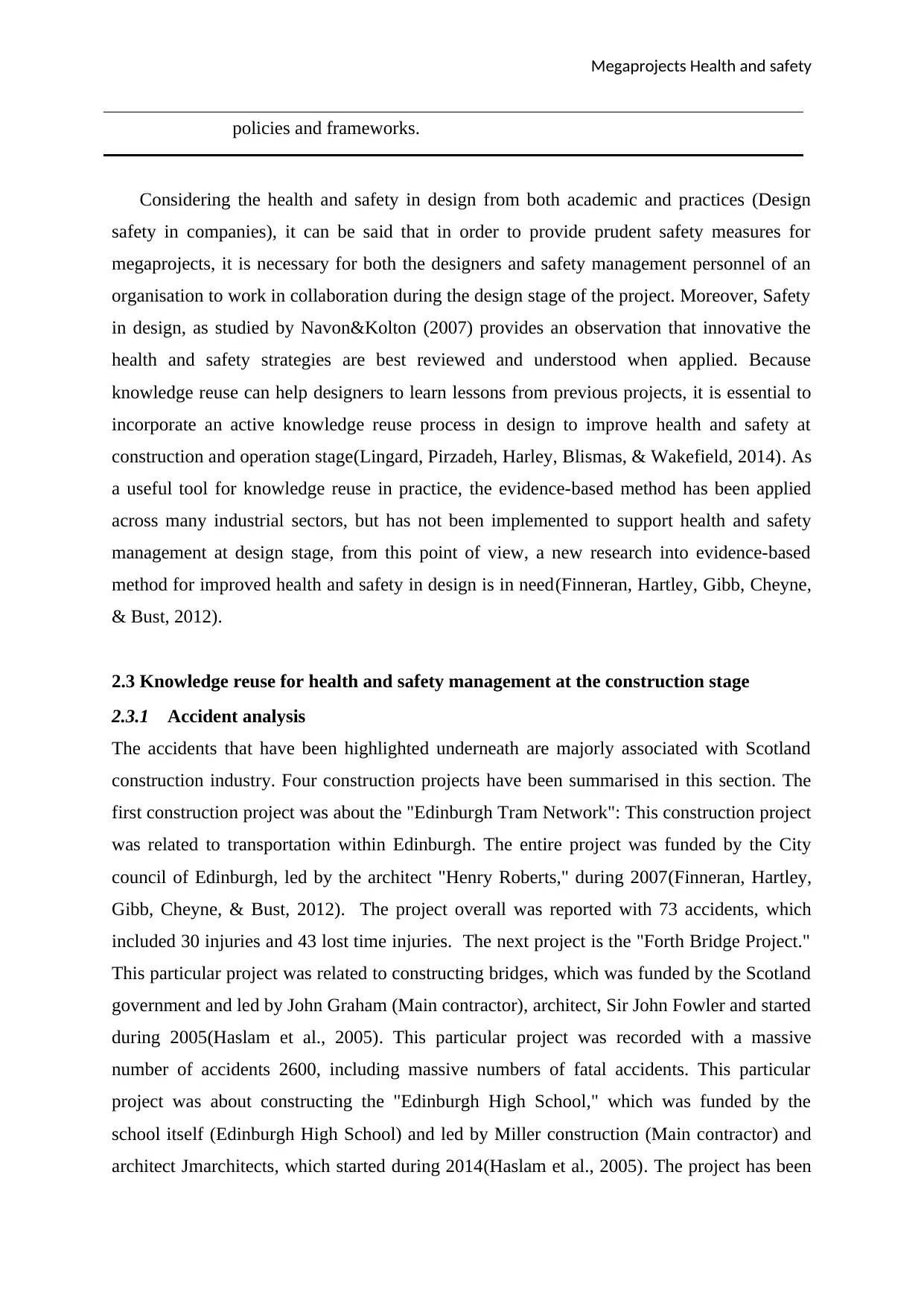
Megaprojects Health and safety
policies and frameworks.
Considering the health and safety in design from both academic and practices (Design
safety in companies), it can be said that in order to provide prudent safety measures for
megaprojects, it is necessary for both the designers and safety management personnel of an
organisation to work in collaboration during the design stage of the project. Moreover, Safety
in design, as studied by Navon&Kolton (2007) provides an observation that innovative the
health and safety strategies are best reviewed and understood when applied. Because
knowledge reuse can help designers to learn lessons from previous projects, it is essential to
incorporate an active knowledge reuse process in design to improve health and safety at
construction and operation stage(Lingard, Pirzadeh, Harley, Blismas, & Wakefield, 2014). As
a useful tool for knowledge reuse in practice, the evidence-based method has been applied
across many industrial sectors, but has not been implemented to support health and safety
management at design stage, from this point of view, a new research into evidence-based
method for improved health and safety in design is in need(Finneran, Hartley, Gibb, Cheyne,
& Bust, 2012).
2.3 Knowledge reuse for health and safety management at the construction stage
2.3.1 Accident analysis
The accidents that have been highlighted underneath are majorly associated with Scotland
construction industry. Four construction projects have been summarised in this section. The
first construction project was about the "Edinburgh Tram Network": This construction project
was related to transportation within Edinburgh. The entire project was funded by the City
council of Edinburgh, led by the architect "Henry Roberts," during 2007(Finneran, Hartley,
Gibb, Cheyne, & Bust, 2012). The project overall was reported with 73 accidents, which
included 30 injuries and 43 lost time injuries. The next project is the "Forth Bridge Project."
This particular project was related to constructing bridges, which was funded by the Scotland
government and led by John Graham (Main contractor), architect, Sir John Fowler and started
during 2005(Haslam et al., 2005). This particular project was recorded with a massive
number of accidents 2600, including massive numbers of fatal accidents. This particular
project was about constructing the "Edinburgh High School," which was funded by the
school itself (Edinburgh High School) and led by Miller construction (Main contractor) and
architect Jmarchitects, which started during 2014(Haslam et al., 2005). The project has been
policies and frameworks.
Considering the health and safety in design from both academic and practices (Design
safety in companies), it can be said that in order to provide prudent safety measures for
megaprojects, it is necessary for both the designers and safety management personnel of an
organisation to work in collaboration during the design stage of the project. Moreover, Safety
in design, as studied by Navon&Kolton (2007) provides an observation that innovative the
health and safety strategies are best reviewed and understood when applied. Because
knowledge reuse can help designers to learn lessons from previous projects, it is essential to
incorporate an active knowledge reuse process in design to improve health and safety at
construction and operation stage(Lingard, Pirzadeh, Harley, Blismas, & Wakefield, 2014). As
a useful tool for knowledge reuse in practice, the evidence-based method has been applied
across many industrial sectors, but has not been implemented to support health and safety
management at design stage, from this point of view, a new research into evidence-based
method for improved health and safety in design is in need(Finneran, Hartley, Gibb, Cheyne,
& Bust, 2012).
2.3 Knowledge reuse for health and safety management at the construction stage
2.3.1 Accident analysis
The accidents that have been highlighted underneath are majorly associated with Scotland
construction industry. Four construction projects have been summarised in this section. The
first construction project was about the "Edinburgh Tram Network": This construction project
was related to transportation within Edinburgh. The entire project was funded by the City
council of Edinburgh, led by the architect "Henry Roberts," during 2007(Finneran, Hartley,
Gibb, Cheyne, & Bust, 2012). The project overall was reported with 73 accidents, which
included 30 injuries and 43 lost time injuries. The next project is the "Forth Bridge Project."
This particular project was related to constructing bridges, which was funded by the Scotland
government and led by John Graham (Main contractor), architect, Sir John Fowler and started
during 2005(Haslam et al., 2005). This particular project was recorded with a massive
number of accidents 2600, including massive numbers of fatal accidents. This particular
project was about constructing the "Edinburgh High School," which was funded by the
school itself (Edinburgh High School) and led by Miller construction (Main contractor) and
architect Jmarchitects, which started during 2014(Haslam et al., 2005). The project has been
⊘ This is a preview!⊘
Do you want full access?
Subscribe today to unlock all pages.

Trusted by 1+ million students worldwide
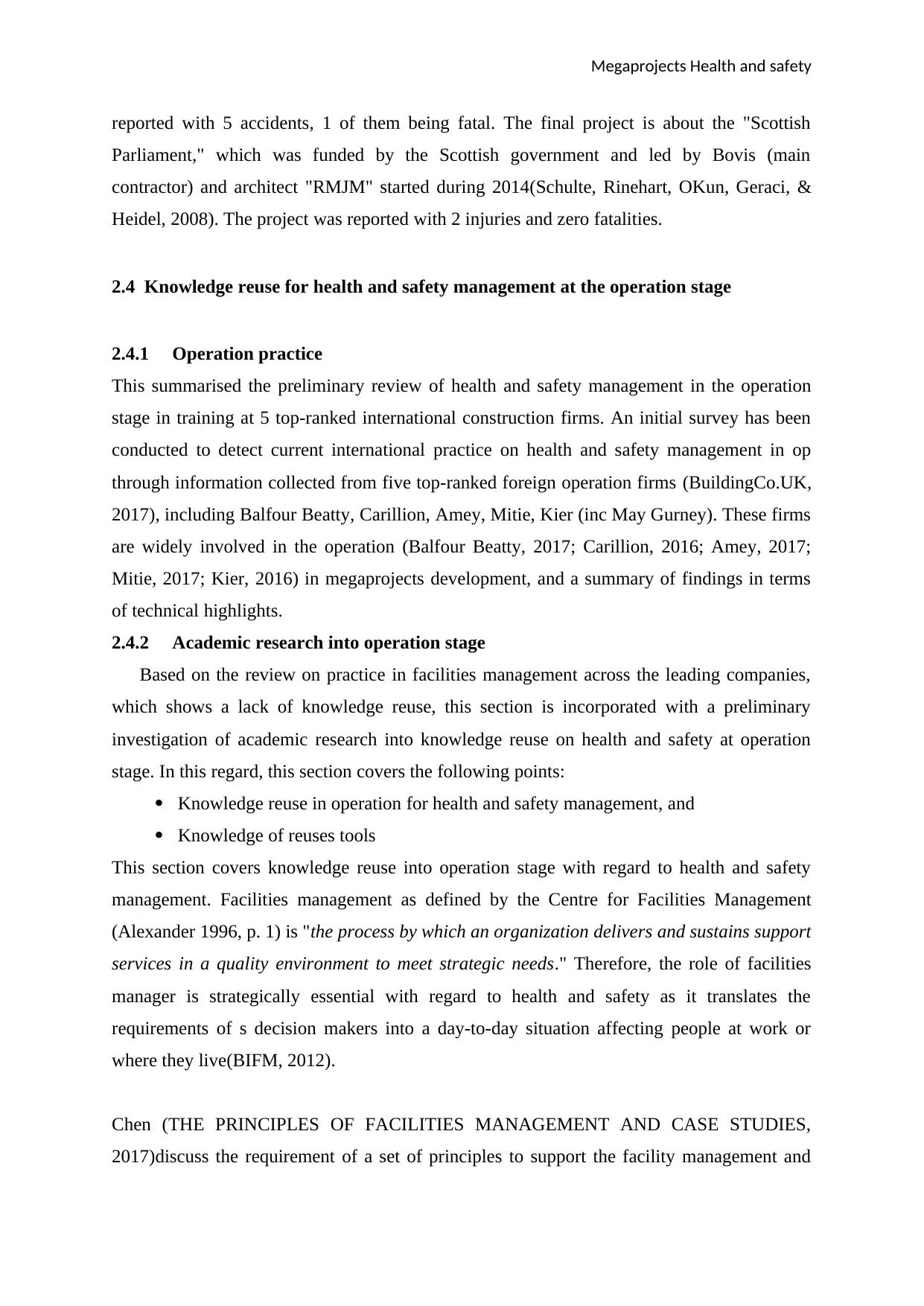
Megaprojects Health and safety
reported with 5 accidents, 1 of them being fatal. The final project is about the "Scottish
Parliament," which was funded by the Scottish government and led by Bovis (main
contractor) and architect "RMJM" started during 2014(Schulte, Rinehart, OKun, Geraci, &
Heidel, 2008). The project was reported with 2 injuries and zero fatalities.
2.4 Knowledge reuse for health and safety management at the operation stage
2.4.1 Operation practice
This summarised the preliminary review of health and safety management in the operation
stage in training at 5 top-ranked international construction firms. An initial survey has been
conducted to detect current international practice on health and safety management in op
through information collected from five top-ranked foreign operation firms (BuildingCo.UK,
2017), including Balfour Beatty, Carillion, Amey, Mitie, Kier (inc May Gurney). These firms
are widely involved in the operation (Balfour Beatty, 2017; Carillion, 2016; Amey, 2017;
Mitie, 2017; Kier, 2016) in megaprojects development, and a summary of findings in terms
of technical highlights.
2.4.2 Academic research into operation stage
Based on the review on practice in facilities management across the leading companies,
which shows a lack of knowledge reuse, this section is incorporated with a preliminary
investigation of academic research into knowledge reuse on health and safety at operation
stage. In this regard, this section covers the following points:
Knowledge reuse in operation for health and safety management, and
Knowledge of reuses tools
This section covers knowledge reuse into operation stage with regard to health and safety
management. Facilities management as defined by the Centre for Facilities Management
(Alexander 1996, p. 1) is "the process by which an organization delivers and sustains support
services in a quality environment to meet strategic needs." Therefore, the role of facilities
manager is strategically essential with regard to health and safety as it translates the
requirements of s decision makers into a day-to-day situation affecting people at work or
where they live(BIFM, 2012).
Chen (THE PRINCIPLES OF FACILITIES MANAGEMENT AND CASE STUDIES,
2017)discuss the requirement of a set of principles to support the facility management and
reported with 5 accidents, 1 of them being fatal. The final project is about the "Scottish
Parliament," which was funded by the Scottish government and led by Bovis (main
contractor) and architect "RMJM" started during 2014(Schulte, Rinehart, OKun, Geraci, &
Heidel, 2008). The project was reported with 2 injuries and zero fatalities.
2.4 Knowledge reuse for health and safety management at the operation stage
2.4.1 Operation practice
This summarised the preliminary review of health and safety management in the operation
stage in training at 5 top-ranked international construction firms. An initial survey has been
conducted to detect current international practice on health and safety management in op
through information collected from five top-ranked foreign operation firms (BuildingCo.UK,
2017), including Balfour Beatty, Carillion, Amey, Mitie, Kier (inc May Gurney). These firms
are widely involved in the operation (Balfour Beatty, 2017; Carillion, 2016; Amey, 2017;
Mitie, 2017; Kier, 2016) in megaprojects development, and a summary of findings in terms
of technical highlights.
2.4.2 Academic research into operation stage
Based on the review on practice in facilities management across the leading companies,
which shows a lack of knowledge reuse, this section is incorporated with a preliminary
investigation of academic research into knowledge reuse on health and safety at operation
stage. In this regard, this section covers the following points:
Knowledge reuse in operation for health and safety management, and
Knowledge of reuses tools
This section covers knowledge reuse into operation stage with regard to health and safety
management. Facilities management as defined by the Centre for Facilities Management
(Alexander 1996, p. 1) is "the process by which an organization delivers and sustains support
services in a quality environment to meet strategic needs." Therefore, the role of facilities
manager is strategically essential with regard to health and safety as it translates the
requirements of s decision makers into a day-to-day situation affecting people at work or
where they live(BIFM, 2012).
Chen (THE PRINCIPLES OF FACILITIES MANAGEMENT AND CASE STUDIES,
2017)discuss the requirement of a set of principles to support the facility management and
Paraphrase This Document
Need a fresh take? Get an instant paraphrase of this document with our AI Paraphraser
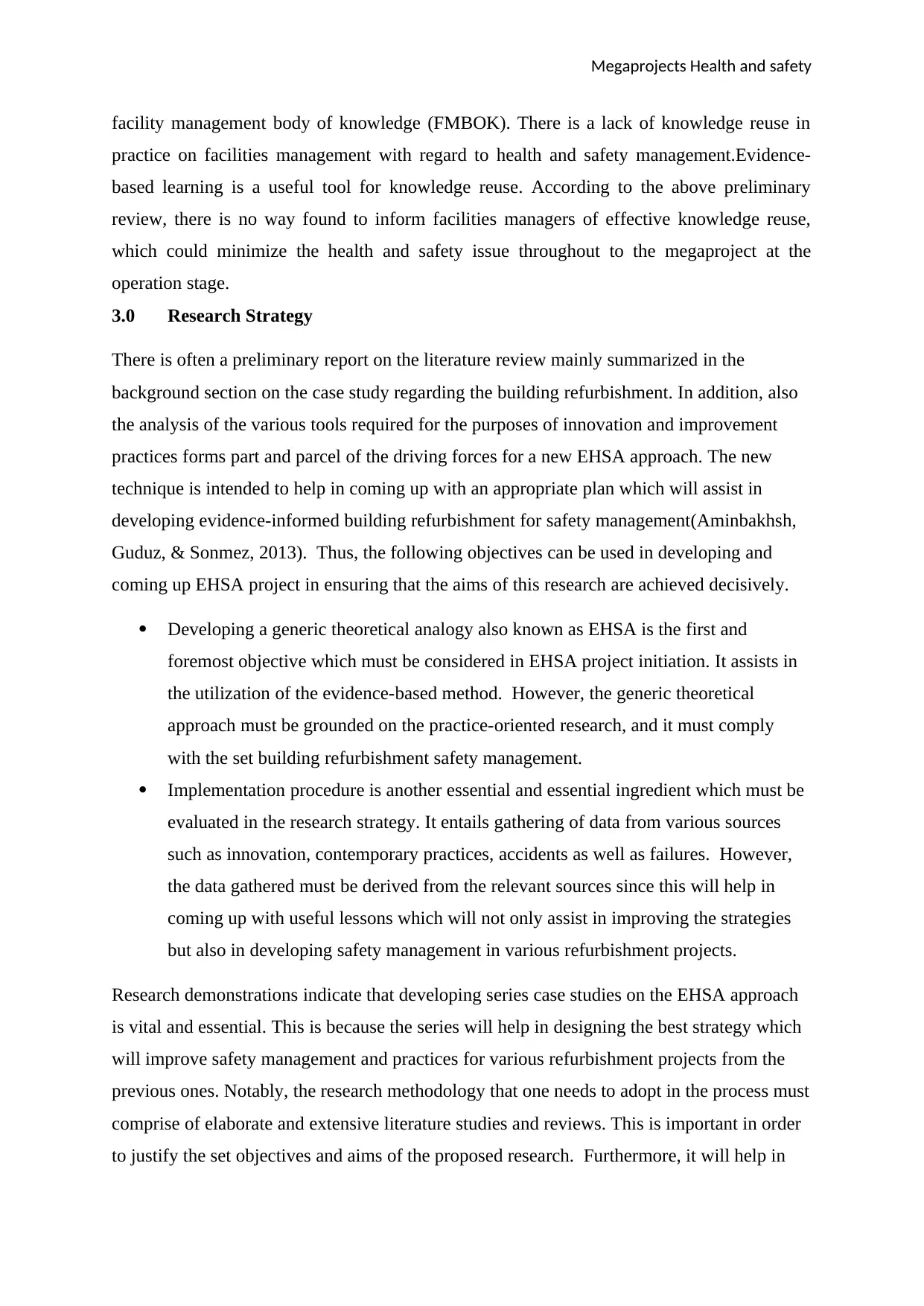
Megaprojects Health and safety
facility management body of knowledge (FMBOK). There is a lack of knowledge reuse in
practice on facilities management with regard to health and safety management.Evidence-
based learning is a useful tool for knowledge reuse. According to the above preliminary
review, there is no way found to inform facilities managers of effective knowledge reuse,
which could minimize the health and safety issue throughout to the megaproject at the
operation stage.
3.0 Research Strategy
There is often a preliminary report on the literature review mainly summarized in the
background section on the case study regarding the building refurbishment. In addition, also
the analysis of the various tools required for the purposes of innovation and improvement
practices forms part and parcel of the driving forces for a new EHSA approach. The new
technique is intended to help in coming up with an appropriate plan which will assist in
developing evidence-informed building refurbishment for safety management(Aminbakhsh,
Guduz, & Sonmez, 2013). Thus, the following objectives can be used in developing and
coming up EHSA project in ensuring that the aims of this research are achieved decisively.
Developing a generic theoretical analogy also known as EHSA is the first and
foremost objective which must be considered in EHSA project initiation. It assists in
the utilization of the evidence-based method. However, the generic theoretical
approach must be grounded on the practice-oriented research, and it must comply
with the set building refurbishment safety management.
Implementation procedure is another essential and essential ingredient which must be
evaluated in the research strategy. It entails gathering of data from various sources
such as innovation, contemporary practices, accidents as well as failures. However,
the data gathered must be derived from the relevant sources since this will help in
coming up with useful lessons which will not only assist in improving the strategies
but also in developing safety management in various refurbishment projects.
Research demonstrations indicate that developing series case studies on the EHSA approach
is vital and essential. This is because the series will help in designing the best strategy which
will improve safety management and practices for various refurbishment projects from the
previous ones. Notably, the research methodology that one needs to adopt in the process must
comprise of elaborate and extensive literature studies and reviews. This is important in order
to justify the set objectives and aims of the proposed research. Furthermore, it will help in
facility management body of knowledge (FMBOK). There is a lack of knowledge reuse in
practice on facilities management with regard to health and safety management.Evidence-
based learning is a useful tool for knowledge reuse. According to the above preliminary
review, there is no way found to inform facilities managers of effective knowledge reuse,
which could minimize the health and safety issue throughout to the megaproject at the
operation stage.
3.0 Research Strategy
There is often a preliminary report on the literature review mainly summarized in the
background section on the case study regarding the building refurbishment. In addition, also
the analysis of the various tools required for the purposes of innovation and improvement
practices forms part and parcel of the driving forces for a new EHSA approach. The new
technique is intended to help in coming up with an appropriate plan which will assist in
developing evidence-informed building refurbishment for safety management(Aminbakhsh,
Guduz, & Sonmez, 2013). Thus, the following objectives can be used in developing and
coming up EHSA project in ensuring that the aims of this research are achieved decisively.
Developing a generic theoretical analogy also known as EHSA is the first and
foremost objective which must be considered in EHSA project initiation. It assists in
the utilization of the evidence-based method. However, the generic theoretical
approach must be grounded on the practice-oriented research, and it must comply
with the set building refurbishment safety management.
Implementation procedure is another essential and essential ingredient which must be
evaluated in the research strategy. It entails gathering of data from various sources
such as innovation, contemporary practices, accidents as well as failures. However,
the data gathered must be derived from the relevant sources since this will help in
coming up with useful lessons which will not only assist in improving the strategies
but also in developing safety management in various refurbishment projects.
Research demonstrations indicate that developing series case studies on the EHSA approach
is vital and essential. This is because the series will help in designing the best strategy which
will improve safety management and practices for various refurbishment projects from the
previous ones. Notably, the research methodology that one needs to adopt in the process must
comprise of elaborate and extensive literature studies and reviews. This is important in order
to justify the set objectives and aims of the proposed research. Furthermore, it will help in
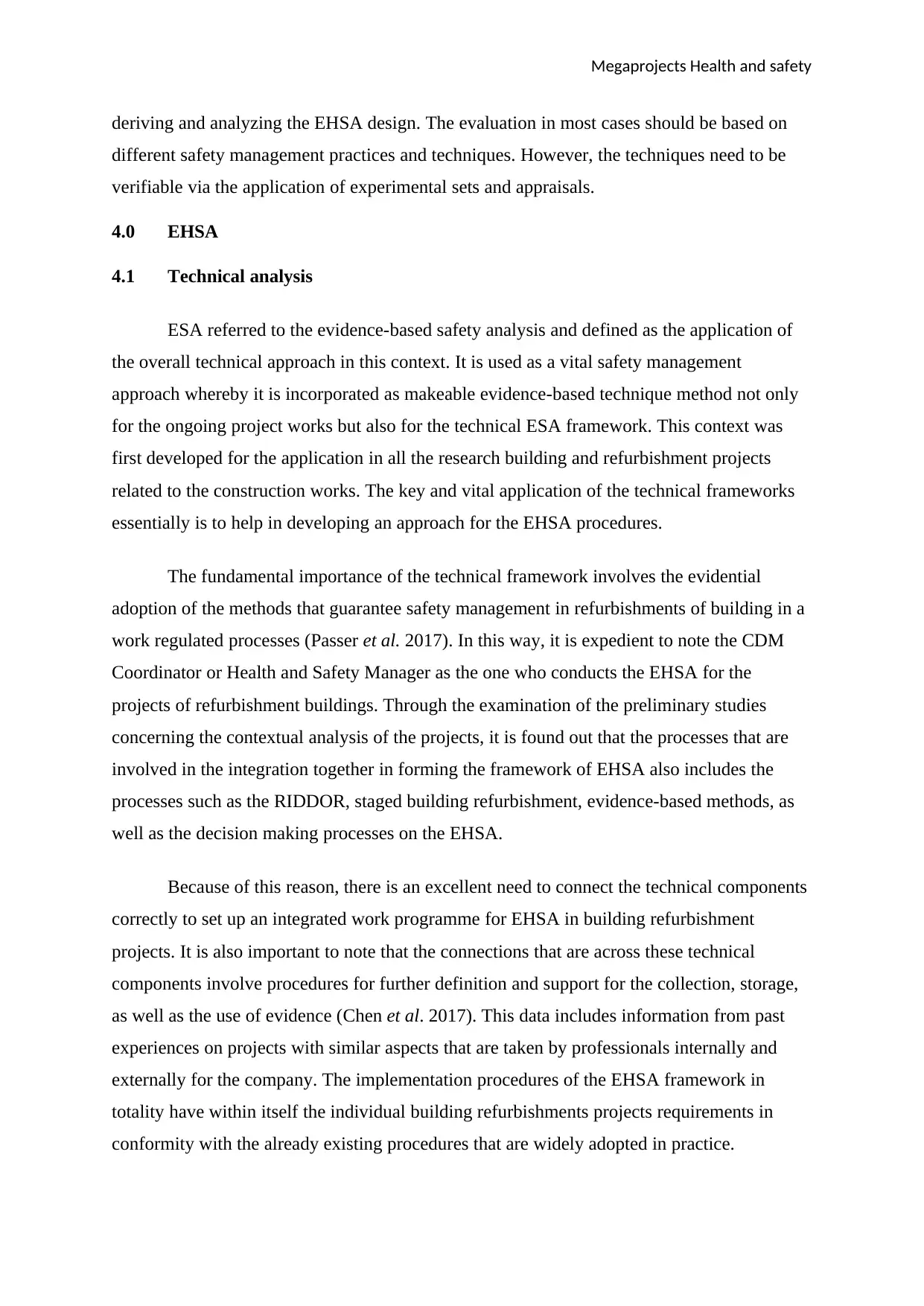
Megaprojects Health and safety
deriving and analyzing the EHSA design. The evaluation in most cases should be based on
different safety management practices and techniques. However, the techniques need to be
verifiable via the application of experimental sets and appraisals.
4.0 EHSA
4.1 Technical analysis
ESA referred to the evidence-based safety analysis and defined as the application of
the overall technical approach in this context. It is used as a vital safety management
approach whereby it is incorporated as makeable evidence-based technique method not only
for the ongoing project works but also for the technical ESA framework. This context was
first developed for the application in all the research building and refurbishment projects
related to the construction works. The key and vital application of the technical frameworks
essentially is to help in developing an approach for the EHSA procedures.
The fundamental importance of the technical framework involves the evidential
adoption of the methods that guarantee safety management in refurbishments of building in a
work regulated processes (Passer et al. 2017). In this way, it is expedient to note the CDM
Coordinator or Health and Safety Manager as the one who conducts the EHSA for the
projects of refurbishment buildings. Through the examination of the preliminary studies
concerning the contextual analysis of the projects, it is found out that the processes that are
involved in the integration together in forming the framework of EHSA also includes the
processes such as the RIDDOR, staged building refurbishment, evidence-based methods, as
well as the decision making processes on the EHSA.
Because of this reason, there is an excellent need to connect the technical components
correctly to set up an integrated work programme for EHSA in building refurbishment
projects. It is also important to note that the connections that are across these technical
components involve procedures for further definition and support for the collection, storage,
as well as the use of evidence (Chen et al. 2017). This data includes information from past
experiences on projects with similar aspects that are taken by professionals internally and
externally for the company. The implementation procedures of the EHSA framework in
totality have within itself the individual building refurbishments projects requirements in
conformity with the already existing procedures that are widely adopted in practice.
deriving and analyzing the EHSA design. The evaluation in most cases should be based on
different safety management practices and techniques. However, the techniques need to be
verifiable via the application of experimental sets and appraisals.
4.0 EHSA
4.1 Technical analysis
ESA referred to the evidence-based safety analysis and defined as the application of
the overall technical approach in this context. It is used as a vital safety management
approach whereby it is incorporated as makeable evidence-based technique method not only
for the ongoing project works but also for the technical ESA framework. This context was
first developed for the application in all the research building and refurbishment projects
related to the construction works. The key and vital application of the technical frameworks
essentially is to help in developing an approach for the EHSA procedures.
The fundamental importance of the technical framework involves the evidential
adoption of the methods that guarantee safety management in refurbishments of building in a
work regulated processes (Passer et al. 2017). In this way, it is expedient to note the CDM
Coordinator or Health and Safety Manager as the one who conducts the EHSA for the
projects of refurbishment buildings. Through the examination of the preliminary studies
concerning the contextual analysis of the projects, it is found out that the processes that are
involved in the integration together in forming the framework of EHSA also includes the
processes such as the RIDDOR, staged building refurbishment, evidence-based methods, as
well as the decision making processes on the EHSA.
Because of this reason, there is an excellent need to connect the technical components
correctly to set up an integrated work programme for EHSA in building refurbishment
projects. It is also important to note that the connections that are across these technical
components involve procedures for further definition and support for the collection, storage,
as well as the use of evidence (Chen et al. 2017). This data includes information from past
experiences on projects with similar aspects that are taken by professionals internally and
externally for the company. The implementation procedures of the EHSA framework in
totality have within itself the individual building refurbishments projects requirements in
conformity with the already existing procedures that are widely adopted in practice.
⊘ This is a preview!⊘
Do you want full access?
Subscribe today to unlock all pages.

Trusted by 1+ million students worldwide
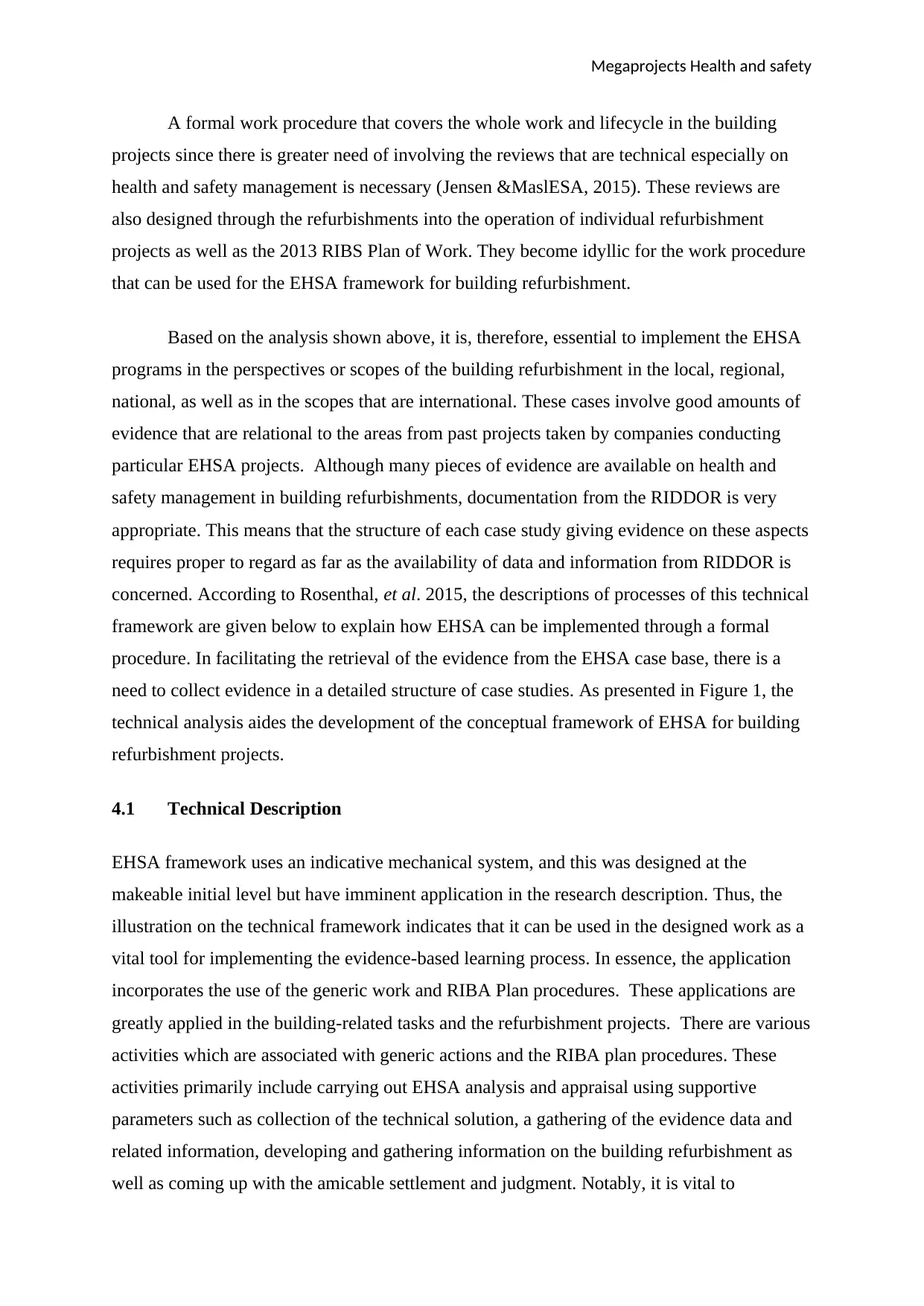
Megaprojects Health and safety
A formal work procedure that covers the whole work and lifecycle in the building
projects since there is greater need of involving the reviews that are technical especially on
health and safety management is necessary (Jensen &MaslESA, 2015). These reviews are
also designed through the refurbishments into the operation of individual refurbishment
projects as well as the 2013 RIBS Plan of Work. They become idyllic for the work procedure
that can be used for the EHSA framework for building refurbishment.
Based on the analysis shown above, it is, therefore, essential to implement the EHSA
programs in the perspectives or scopes of the building refurbishment in the local, regional,
national, as well as in the scopes that are international. These cases involve good amounts of
evidence that are relational to the areas from past projects taken by companies conducting
particular EHSA projects. Although many pieces of evidence are available on health and
safety management in building refurbishments, documentation from the RIDDOR is very
appropriate. This means that the structure of each case study giving evidence on these aspects
requires proper to regard as far as the availability of data and information from RIDDOR is
concerned. According to Rosenthal, et al. 2015, the descriptions of processes of this technical
framework are given below to explain how EHSA can be implemented through a formal
procedure. In facilitating the retrieval of the evidence from the EHSA case base, there is a
need to collect evidence in a detailed structure of case studies. As presented in Figure 1, the
technical analysis aides the development of the conceptual framework of EHSA for building
refurbishment projects.
4.1 Technical Description
EHSA framework uses an indicative mechanical system, and this was designed at the
makeable initial level but have imminent application in the research description. Thus, the
illustration on the technical framework indicates that it can be used in the designed work as a
vital tool for implementing the evidence-based learning process. In essence, the application
incorporates the use of the generic work and RIBA Plan procedures. These applications are
greatly applied in the building-related tasks and the refurbishment projects. There are various
activities which are associated with generic actions and the RIBA plan procedures. These
activities primarily include carrying out EHSA analysis and appraisal using supportive
parameters such as collection of the technical solution, a gathering of the evidence data and
related information, developing and gathering information on the building refurbishment as
well as coming up with the amicable settlement and judgment. Notably, it is vital to
A formal work procedure that covers the whole work and lifecycle in the building
projects since there is greater need of involving the reviews that are technical especially on
health and safety management is necessary (Jensen &MaslESA, 2015). These reviews are
also designed through the refurbishments into the operation of individual refurbishment
projects as well as the 2013 RIBS Plan of Work. They become idyllic for the work procedure
that can be used for the EHSA framework for building refurbishment.
Based on the analysis shown above, it is, therefore, essential to implement the EHSA
programs in the perspectives or scopes of the building refurbishment in the local, regional,
national, as well as in the scopes that are international. These cases involve good amounts of
evidence that are relational to the areas from past projects taken by companies conducting
particular EHSA projects. Although many pieces of evidence are available on health and
safety management in building refurbishments, documentation from the RIDDOR is very
appropriate. This means that the structure of each case study giving evidence on these aspects
requires proper to regard as far as the availability of data and information from RIDDOR is
concerned. According to Rosenthal, et al. 2015, the descriptions of processes of this technical
framework are given below to explain how EHSA can be implemented through a formal
procedure. In facilitating the retrieval of the evidence from the EHSA case base, there is a
need to collect evidence in a detailed structure of case studies. As presented in Figure 1, the
technical analysis aides the development of the conceptual framework of EHSA for building
refurbishment projects.
4.1 Technical Description
EHSA framework uses an indicative mechanical system, and this was designed at the
makeable initial level but have imminent application in the research description. Thus, the
illustration on the technical framework indicates that it can be used in the designed work as a
vital tool for implementing the evidence-based learning process. In essence, the application
incorporates the use of the generic work and RIBA Plan procedures. These applications are
greatly applied in the building-related tasks and the refurbishment projects. There are various
activities which are associated with generic actions and the RIBA plan procedures. These
activities primarily include carrying out EHSA analysis and appraisal using supportive
parameters such as collection of the technical solution, a gathering of the evidence data and
related information, developing and gathering information on the building refurbishment as
well as coming up with the amicable settlement and judgment. Notably, it is vital to
Paraphrase This Document
Need a fresh take? Get an instant paraphrase of this document with our AI Paraphraser

Megaprojects Health and safety
demarcate that the technical judgment made is grounded on the intended execution plan as
well as solution assessment criteria used. All the analysis at this phase mainly considered in
line with the safety and healthcare management. There various technical steps which are used
in carrying out the EHSA process and these steps include
Step 1: Developing and preparing amicable checkpoints and evaluation criteria for
reviewing the health and assessment. These preparations and inspections must be
carried for various individual works at designated building refurbishment stages.
Step 2: Gathering all the evidence pertaining both the internal as well as the external
reported diseases, injuries alongside dangerous occurrences. Additionally, it is
essential to collect and appraise the information and data relating to different past
projects which are similar to the proposed one and their related past practices.
Step 3: At this stage, it is essential to evaluate all the technical solution regarding the
refurbishment project, and this must comply with the individual work carried out in
various stages.
Ascione et al. (2014) noted that there are various case studies obtained from the EHSA
analysis. In most cases, the evaluations are grounded on the information, and the data
gathered and documented formally. There are different regulations and the stipulated law
which may be considered in the process and these tends to include dangerous occurrence
regulations, diseases and reported injuries. In developing the case to be used in the EHSA
process, prototypes often assist in gathering all the technical evidence. The professional
shreds of evidence usually obtained from the past projects and related scopes and these tend
to cover the various practices such as the international, regional, national as well as the local
scale. In the adoption of the EHSA technique, it is expected that process which will be used
in gathering all the relevant documentation and data has to be carried out using both the
external and the internal sources. These sources have to be incorporated and obtained from
the organization. Conversely, it is crucial and vital to know that the main reason of gathering
and collecting the makeable case studies reports is to ensure that there is reliable evidence to
be utilized in the development of the EHSA.
EHSA will require that imminent and decisive data is gathered and collected both for the
safety and health management in line with the proposed project. However, it will be
important not only to consider the internal data but also to gather relevant information and
reports. These have to be correlated with the dangerous occurrences, injuries as well as the
demarcate that the technical judgment made is grounded on the intended execution plan as
well as solution assessment criteria used. All the analysis at this phase mainly considered in
line with the safety and healthcare management. There various technical steps which are used
in carrying out the EHSA process and these steps include
Step 1: Developing and preparing amicable checkpoints and evaluation criteria for
reviewing the health and assessment. These preparations and inspections must be
carried for various individual works at designated building refurbishment stages.
Step 2: Gathering all the evidence pertaining both the internal as well as the external
reported diseases, injuries alongside dangerous occurrences. Additionally, it is
essential to collect and appraise the information and data relating to different past
projects which are similar to the proposed one and their related past practices.
Step 3: At this stage, it is essential to evaluate all the technical solution regarding the
refurbishment project, and this must comply with the individual work carried out in
various stages.
Ascione et al. (2014) noted that there are various case studies obtained from the EHSA
analysis. In most cases, the evaluations are grounded on the information, and the data
gathered and documented formally. There are different regulations and the stipulated law
which may be considered in the process and these tends to include dangerous occurrence
regulations, diseases and reported injuries. In developing the case to be used in the EHSA
process, prototypes often assist in gathering all the technical evidence. The professional
shreds of evidence usually obtained from the past projects and related scopes and these tend
to cover the various practices such as the international, regional, national as well as the local
scale. In the adoption of the EHSA technique, it is expected that process which will be used
in gathering all the relevant documentation and data has to be carried out using both the
external and the internal sources. These sources have to be incorporated and obtained from
the organization. Conversely, it is crucial and vital to know that the main reason of gathering
and collecting the makeable case studies reports is to ensure that there is reliable evidence to
be utilized in the development of the EHSA.
EHSA will require that imminent and decisive data is gathered and collected both for the
safety and health management in line with the proposed project. However, it will be
important not only to consider the internal data but also to gather relevant information and
reports. These have to be correlated with the dangerous occurrences, injuries as well as the
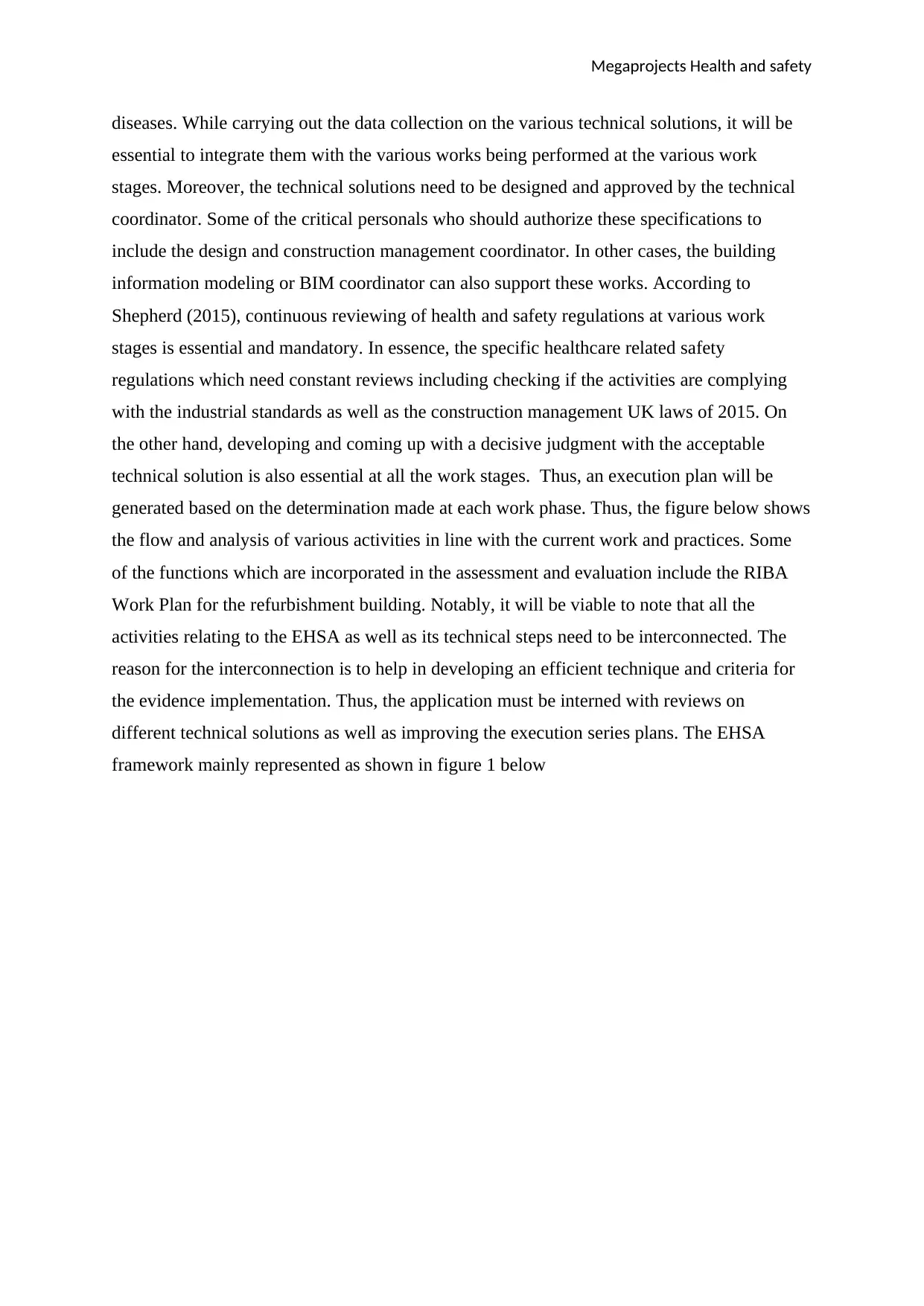
Megaprojects Health and safety
diseases. While carrying out the data collection on the various technical solutions, it will be
essential to integrate them with the various works being performed at the various work
stages. Moreover, the technical solutions need to be designed and approved by the technical
coordinator. Some of the critical personals who should authorize these specifications to
include the design and construction management coordinator. In other cases, the building
information modeling or BIM coordinator can also support these works. According to
Shepherd (2015), continuous reviewing of health and safety regulations at various work
stages is essential and mandatory. In essence, the specific healthcare related safety
regulations which need constant reviews including checking if the activities are complying
with the industrial standards as well as the construction management UK laws of 2015. On
the other hand, developing and coming up with a decisive judgment with the acceptable
technical solution is also essential at all the work stages. Thus, an execution plan will be
generated based on the determination made at each work phase. Thus, the figure below shows
the flow and analysis of various activities in line with the current work and practices. Some
of the functions which are incorporated in the assessment and evaluation include the RIBA
Work Plan for the refurbishment building. Notably, it will be viable to note that all the
activities relating to the EHSA as well as its technical steps need to be interconnected. The
reason for the interconnection is to help in developing an efficient technique and criteria for
the evidence implementation. Thus, the application must be interned with reviews on
different technical solutions as well as improving the execution series plans. The EHSA
framework mainly represented as shown in figure 1 below
diseases. While carrying out the data collection on the various technical solutions, it will be
essential to integrate them with the various works being performed at the various work
stages. Moreover, the technical solutions need to be designed and approved by the technical
coordinator. Some of the critical personals who should authorize these specifications to
include the design and construction management coordinator. In other cases, the building
information modeling or BIM coordinator can also support these works. According to
Shepherd (2015), continuous reviewing of health and safety regulations at various work
stages is essential and mandatory. In essence, the specific healthcare related safety
regulations which need constant reviews including checking if the activities are complying
with the industrial standards as well as the construction management UK laws of 2015. On
the other hand, developing and coming up with a decisive judgment with the acceptable
technical solution is also essential at all the work stages. Thus, an execution plan will be
generated based on the determination made at each work phase. Thus, the figure below shows
the flow and analysis of various activities in line with the current work and practices. Some
of the functions which are incorporated in the assessment and evaluation include the RIBA
Work Plan for the refurbishment building. Notably, it will be viable to note that all the
activities relating to the EHSA as well as its technical steps need to be interconnected. The
reason for the interconnection is to help in developing an efficient technique and criteria for
the evidence implementation. Thus, the application must be interned with reviews on
different technical solutions as well as improving the execution series plans. The EHSA
framework mainly represented as shown in figure 1 below
⊘ This is a preview!⊘
Do you want full access?
Subscribe today to unlock all pages.

Trusted by 1+ million students worldwide
1 out of 31
Related Documents
Your All-in-One AI-Powered Toolkit for Academic Success.
+13062052269
info@desklib.com
Available 24*7 on WhatsApp / Email
![[object Object]](/_next/static/media/star-bottom.7253800d.svg)
Unlock your academic potential
Copyright © 2020–2025 A2Z Services. All Rights Reserved. Developed and managed by ZUCOL.





